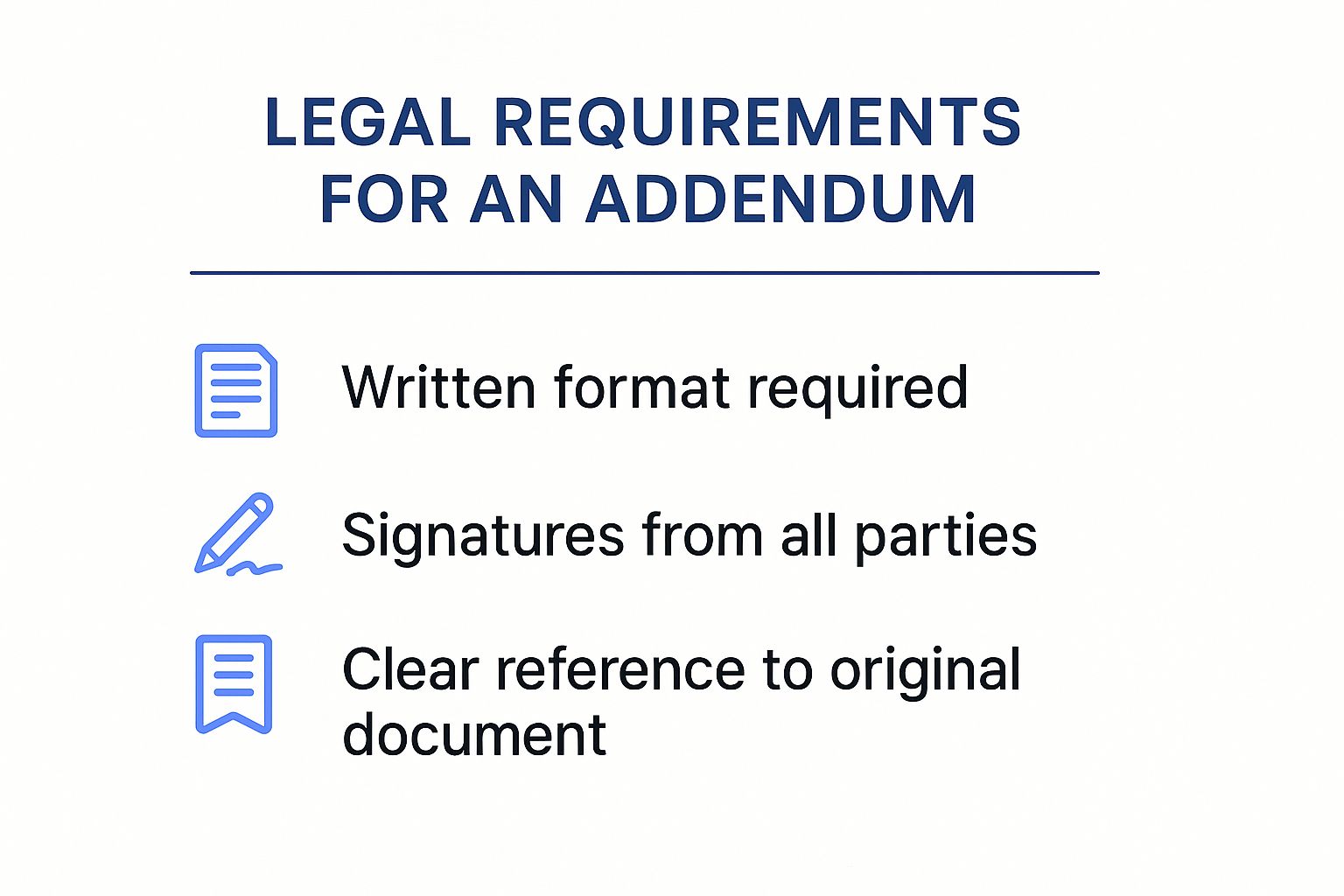
Demystifying Addendum Meaning in Law
An addendum in law is a separate document added to a contract. Its purpose is to modify, clarify, or add information without changing the original agreement's core structure. It's similar to an appendix in a book, offering supplemental information without altering the main text. This differs from an amendment, which directly changes the existing contract content. This distinction is key for preserving the original agreement while adapting it to new situations.
Understanding the Purpose of an Addendum
Addendums are valuable for legal professionals due to their flexibility and efficiency. They can incorporate new clauses, update contact details, or clarify points that became unclear after the initial signing. This avoids the need for a complete contract rewrite, saving time and resources. Addendums also help prevent disputes by clearly documenting agreed-upon changes.

Addendums play a vital role in modifying contracts without complete revisions. They've been widely used in real estate, particularly in the United States. During the early 2000s real estate boom, addendums frequently modified purchase agreements. These often included contingencies like financing or inspections. This flexibility helped transactions proceed smoothly, even with unexpected issues. By 2005, roughly 20% of real estate contracts included addendums for financing or inspection terms, demonstrating their adaptability. Learn more at Investopedia.
Key Characteristics of a Legally Binding Addendum
Several factors ensure a legally sound addendum:
- Clear Reference to the Original Contract: The addendum must clearly identify the contract it modifies.
- Mutual Consent: All parties must agree to and sign the addendum.
- Consistent Language: The addendum's language should be clear, concise, and consistent with the original contract.
- Proper Execution: Execution must follow legal requirements, potentially including notarization or witness signatures.
Practical Applications of Addendums
Addendums are used across various legal areas:
- Real Estate: Common for addressing inspections, financing, or closing date changes.
- Business Contracts: Used to modify service agreements, add products, or update pricing.
- Employment Contracts: Used to document changes to roles, salary, or benefits.
For estate-related addendums, resources like Veterans Estate Planning can be helpful. Carefully crafting your addendums is vital. A well-written addendum clarifies terms, minimizes disputes, and ensures everyone is in agreement.
When Smart Legal Professionals Turn to Addendums
An addendum is a valuable tool in the legal world, allowing professionals to modify existing contracts without starting from scratch. But when is using an addendum the best approach? Experienced legal professionals understand the strategic advantages of addendums, using them to adapt to changing circumstances while preserving the original agreement's core structure.
Common Scenarios for Utilizing Addendums
Addendums offer a practical solution in several situations:
Adding New Terms: When unforeseen situations arise, an addendum seamlessly integrates new terms into the existing contract. Imagine a lease agreement needing to accommodate a tenant's request for pet ownership. An addendum can address this smoothly.
Clarifying Ambiguous Language: If the original contract contains unclear language, an addendum offers a way to provide precise definitions. This proactive approach helps prevent future disagreements and ensures everyone is on the same page.
Correcting Errors: Mistakes happen. An addendum provides a simple method for correcting errors or omissions discovered after the contract is signed. This ensures the agreement accurately reflects the intended terms.
Updating Critical Information: Contact details, payment information, or other important data can change over time. An addendum allows for quick and easy updates to this critical information.
Strategic Advantages of Addendums
Several key advantages contribute to the preference for addendums among legal professionals:
Preserving Contractual Integrity: Addendums modify the agreement without requiring a complete rewrite, minimizing the risk of unintended changes or disruptions to the original contract.
Saving Time and Resources: Drafting an addendum is usually faster and simpler than creating an entirely new contract. This efficiency streamlines the modification process, saving valuable time and resources.
Maintaining Clarity and Organization: Addendums provide a clear record of all contract modifications, making it easy to track the agreement's evolution and understand the current terms.
Recent research highlights the increasing popularity of addendums. Studies show a significant rise in their use in legal documents. A 2020 survey found over 70% of legal professionals preferred addendums to amendments for contract updates, primarily because of their efficiency in modifying specific clauses without complete contract overhauls. You can find more detailed statistics here.
Applying Addendums Across Legal Domains
Addendums are versatile tools used across diverse legal fields:
Real Estate: They're frequently used to address specifics about property inspections, financing contingencies, or closing date adjustments.
Intellectual Property: Addendums can clarify licensing agreements, ownership rights, or restrictions on using copyrighted materials and patents.
Employment Law: Changes to job duties, salary, or benefits can be formally documented through addendums to employment contracts.

Using addendums strategically demonstrates a deep understanding of contract law. They empower legal professionals to navigate complex contract modifications efficiently and effectively. For more helpful tips on contract management, Legal Document Simplifier offers resources on their blog: Learn more about contract compliance management. These resources can provide you with the tools you need for successful contract management.
Addendum vs. Amendment: Choosing Your Contract Tool

This infographic summarizes the key legal requirements for a valid addendum. It highlights the importance of a written format, signatures from all parties involved, and a clear connection back to the original document. These elements ensure the addendum is legally sound and enforceable. Understanding these core principles is vital for anyone working with contracts. Let's explore the differences between addendums and amendments.
We've already discussed when to use addendums. Now, it's important to understand how they differ from amendments. Both modify contracts, but they do so in distinct ways. This distinction is crucial for maintaining clear and reliable agreements. Using the wrong one can create confusion and even legal problems.
Defining Addendums and Amendments
An addendum adds to a contract without changing the existing terms. Think of it like adding a new chapter to a book: the original story stays the same, but you're adding new information. An amendment, however, changes existing terms within the contract. It's like editing a chapter of a book, altering the original narrative.
Practical Applications: Addendum vs. Amendment
Consider a real estate contract. An addendum might include details about recently discovered property features. An amendment, on the other hand, would be used to change the closing date or the sale price. This process helps preserve the initial agreement while allowing it to adapt to new information or changing circumstances. For more on assessing risk in contracts, check out this helpful resource: How to master contract risk assessments.
Choosing the Right Tool
Whether you use an addendum or an amendment depends on the type and extent of the modifications. For significant changes to core terms, an amendment is usually the best option. For minor additions or clarifications, an addendum is more suitable.
To help illustrate the key differences, let's look at a comparison table:
To understand the differences between addendums and amendments, the following table helps in outlining when to use which one. This comparison will clarify when each contract modification is appropriate.
Addendum vs. Amendment Comparison This table will clearly outline the key differences between addendums and amendments to help readers understand when to use each type of contract modification
| Feature | Addendum | Amendment |
|---|---|---|
| Purpose | Adds new information | Changes existing information |
| Effect | Supplements the original contract | Alters the original contract |
| Example | Adding a contingency clause | Modifying payment terms |
This table clearly shows the differences between addendums and amendments. Understanding these differences is key for effective contract management.
By understanding these distinctions, you can choose the right tool for the job. This ensures your contract modifications are clear, legally sound, and protect your interests. This careful approach to contracts helps prevent future disagreements and builds strong business relationships.
Global Perspectives on Addendum Meaning in Law
Contract law transcends national borders, and so does the concept of an addendum. This section explores the varying meanings and applications of addendums within different legal systems globally. This understanding is vital for businesses and legal professionals working internationally.
Navigating International Contract Law
Each country's legal traditions shape the use of addendums. Common law systems, like those in the US and UK, prioritize precedent and judicial interpretation. Addendums in these jurisdictions often clarify existing terms or address unforeseen issues. Civil law systems, common in Europe and Asia, rely on codified statutes. Addendums here may face stricter formal requirements. These variations underscore the importance of knowing local legal customs.
Terminology and Execution Requirements
Even the term "addendum" has different equivalents across languages. Alternatives like "annex" or "rider" exist in various jurisdictions. Furthermore, execution requirements, such as signatures, witnesses, or notarization, can differ greatly. Consequently, an addendum valid in one country might not be enforceable in another. Multinational legal teams must carefully navigate these complexities.
Addendums and International Regulations
International regulations influence how addendums are used. Data protection regulations, like the GDPR in Europe, have popularized data protection addendums. These addendums supplement existing agreements with specific provisions for handling personal data. Globally, addendums are key for contract clarity and flexibility. Data protection is a major area where they are used, especially in the US and Europe.
Data protection addendums often clarify data handling and ensure privacy compliance within existing agreements. This is crucial with regulations like GDPR, where over 80% of European companies had incorporated data protection addendums by 2022. For more information, see Call Tracking Metrics.
Practical Guidance for Global Addendums
Consider these best practices when drafting international addendums:
- Consult with local counsel: Get expert advice in every relevant jurisdiction to ensure compliance.
- Clearly define governing law: State which jurisdiction’s laws will govern the contract and its addendums.
- Use precise language: Avoid ambiguity that can lead to varied interpretations across legal systems.
- Consider translation and cultural context: Ensure accurate translation and cultural adaptation for each party.
Understanding global perspectives on addendum meaning helps businesses and legal professionals avoid costly errors and create stronger international agreements. This knowledge is crucial for navigating international contract law and maintaining smooth, compliant operations across borders.
Crafting Bulletproof Addendums That Stand Legal Tests

Even small drafting errors can weaken an addendum, creating ambiguity and potentially leading to expensive disputes. Precision and attention to detail are paramount when creating these contract modifications. This section guides you through the essentials of crafting robust, legally sound addendums. For more on contract management, check out this helpful resource: How to master contract compliance management.
Essential Elements of a Valid Addendum
A well-crafted addendum, like a sturdy building, relies on key components for its strength. These elements work together to clearly communicate changes while preserving the original agreement's integrity.
Precise Identification of the Original Agreement: The addendum must clearly identify the original contract it modifies. This includes the contract's title, execution date, and the names of all parties involved. Accurate identification prevents confusion about which agreement is being changed.
Clear and Concise Language: Avoid jargon and complex sentences. Clarity is key. Straightforward language ensures all parties understand the modifications.
Proper Effective Dates: Clearly state when the addendum's modifications take effect. This prevents disagreements about the timing of changes.
Signature Requirements: All parties to the original contract must sign the addendum. Their signatures indicate consent to the modifications and are crucial for enforceability.
To further illustrate these crucial components, let's examine them in a structured format.
To further illustrate these essential components, let's look at them in a table:
Essential Components of a Valid Legal Addendum
| Component | Purpose | Example |
|---|---|---|
| Precise Identification of Original Agreement | Prevents confusion about which contract is modified | "This addendum modifies the contract titled 'Sales Agreement,' executed on January 1, 2024, between Company A and Company B." |
| Clear and Concise Language | Ensures all parties understand the modifications | "The delivery date is changed from March 1, 2024, to April 1, 2024." |
| Proper Effective Dates | Specifies when modifications take effect | "This addendum is effective as of May 1, 2024." |
| Signature Requirements | Demonstrates consent and ensures enforceability | Signatures of authorized representatives from both Company A and Company B. |
This table summarizes the key elements needed for a legally sound addendum. By including these components, you create a document that is clear, enforceable, and minimizes the risk of future disputes.
Structural Frameworks for Clarity and Enforceability
A clear structure is just as important as the individual elements. Successful legal teams use specific frameworks to ensure clarity and enforceability. A well-structured addendum often begins by restating the relevant sections of the original agreement. It then clearly presents the specific changes. Finally, it confirms that all other parts of the original contract remain in effect.
Language Patterns That Prevent Misinterpretation
Specific phrasing can help clarify the relationship between the addendum and the original contract. For example, phrases like "This addendum modifies the original agreement as follows..." or "Notwithstanding anything to the contrary in the original agreement..." can be very helpful. Defining key terms within the addendum itself also prevents ambiguity.
Execution Procedures and Documentation
Proper execution and documentation are essential for proving consent and ensuring the addendum's validity. Obtain signatures from all involved parties and keep copies of both the addendum and the original contract. Consider using witnesses or notarization for added security. Meticulous documentation is crucial in case of disputes.
Common Pitfalls and Practical Checklists
Even experienced professionals can make mistakes. Common errors include failing to identify the original contract clearly, using ambiguous language, or not obtaining all necessary signatures. Checklists are invaluable tools for ensuring you've addressed every essential element. This proactive approach helps prevent costly errors and ensures your addendum is clear, enforceable, and achieves its purpose.
Addendum Applications Across Legal Specialties
Addendums, with their targeted modifications, are vital across various legal fields. Understanding their use in different specialties is key to effective practice. Let's explore how addendums work in specific legal areas.
Addendums in Real Estate Transactions
Real estate deals often use addendums to handle the unique details of property transactions. These additions typically address issues like property inspections, financing contingencies, and closing date changes. For instance, an addendum might detail repairs needed after a home inspection or outline specific financing terms. This keeps the original contract in place while addressing specific points.
Addendums in Business Contracts
In the fast-moving business world, addendums are crucial for adapting contracts to changing situations. They allow businesses to modify service agreements, add new products, or update pricing without completely renegotiating the contract. This flexibility is especially helpful in markets where quick adjustments are often needed.
Addendums in Intellectual Property Agreements
Intellectual property law requires precise language, and addendums are key to clarifying complex agreements. They may detail licensing terms, ownership rights, or usage restrictions for copyrighted material, trademarks, and patents. This ensures all parties understand their rights and obligations concerning the intellectual property. To keep your addendums secure, consider using strong API key security best practices.
Addendums in Healthcare Documentation
Healthcare documentation uses addendums to update patient records, add new medical information, or clarify treatment plans. An addendum might document a patient's medication change or detail recent medical test results. This keeps the patient's file up-to-date with their current health status and treatment progress.
Tailoring Addendums to Specific Needs
Effective legal teams know addendums aren't one-size-fits-all. They adapt their approach to the specific industry, considering regulations and common risks. This customized method ensures the addendum addresses the unique aspects of each legal area. For more on contract management, check out this resource: How to master contract management best practices.
Practical Examples and Templates
Learning from well-written addendums is invaluable. By looking at examples from various legal specialties, professionals can learn about effective formatting, standard clauses, and strategic use. Adaptable templates provide a good base for creating custom addendums that address specific needs and ensure legal soundness. This helps legal professionals draft addendums confidently and effectively.
Simplify legal documents and manage contracts better with Legal Document Simplifier. Our AI-powered platform provides clear summaries of complex legal documents, helping you make informed decisions. Visit Legal Document Simplifier to learn more.